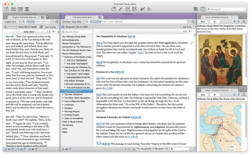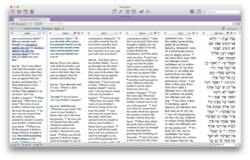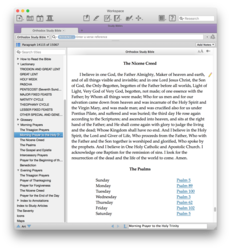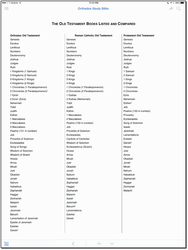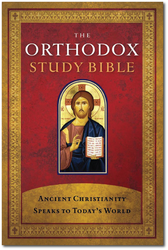 We are pleased to announce the release of the Orthodox Study Bible Notes for the Accordance Library! This unique study Bible, offering insights and commentary from the early centuries of Christianity, will be of interest not only to Eastern Orthodox Christians but also to anyone interested in church history.
We are pleased to announce the release of the Orthodox Study Bible Notes for the Accordance Library! This unique study Bible, offering insights and commentary from the early centuries of Christianity, will be of interest not only to Eastern Orthodox Christians but also to anyone interested in church history.
The content of the OSB–including annotations, introductions, and articles–is written at a vocabulary level of a high school graduate to communicate “the treasures of the Orthodox biblical tradition with clergy and laypeople desirous of understanding their Christian beliefs and making them accessible to others” (Introduction). The notes and commentary emphasize the major themes of the Christian faith, giving special attention to the following:
- The Holy Trinity: Father, Son and Holy Spirit
- The Incarnation: The Divine Son of God becoming Man
- The Centrality of the Church, the “dwelling place of God in the Spirit” (Eph 2:22)
- The Virtues: God’s call to His people to live righteous and holy lives in Christ
Click/tap on the image above to see a larger view
of the Orthodox Study Bible in Accordance 11.
Read on to learn about some of standout features of the Orthodox Study Bible.
The St. Athanasius Academy Septuagint & the English Orthodox Bible
Accordance users have always enjoyed the freedom to pair any translation or original language text of the Bible with any set of study Bible notes, and this remains true with the OSB. However, since the Old Testament of the OSB follows the Septuagint (LXX) and not the Hebrew Bible, included with every copy of the OSB is the St. Athanasius Academy Septuagint, a new English version of the LXX created specifically to accompany the Old Testament annotations of the OSB. The SAAS began with the New King James Version as its base, but changes were made at any point where the LXX differed from the Hebrew text. Moreover, brand new translations were created for the additional books (often referred to as Apocrypha or Deuterocanon) not found in the NKJV. The translation of these additional Old Testament books use the NKJV style and vocabulary as a template to maintain a consistent look and feel throughout the OSB.
Side note: The addition of the SAAS translation joins Brenton’s translation of the LXX and the New English Translation of the Septuagint (NETS) for a total of three LXX translations in the Accordance Library for comparison and study.
We are also making available a new combined text, the English Orthodox Bible, that includes the SAAS Old Testament and the NKJV New Testament. This is a free upgrade to those who already own the NKJV or NKJVS and purchase the Orthodox Study Bible. As a combined Bible text covering both Testaments, it provides a complete English text companion for the OSB.
Interestingly, since the New Testament of the OSB is paired with an Old Testament based on the Septuagint—the Bible used by the writers of the New Testament—when the New Testament quotes the Old, the quotations are worded identically, unlike most Bibles with Old Testaments based on the Hebrew text.
Commentary Drawn from the Early Church Christians
Commentary notes, or annotations, serve as the defining characteristic of study Bibles. The OSB is no different except that its comments originate not from the interpretation of modern Bible scholars, but rather from over 50 early church sources. These notes not only draw upon the biblical and theological understandings of individuals such as Athanasius, Irenaeus, and Chrysostom, they also gear themselves toward the life and practice of Orthodox Christians.
For instance, regarding Genesis 1:3, “Then God said, ‘Let there be light’; and there was light” (SAAS), the OSB includes this note drawing on the teachings of both Athanasius the Great as well as the Canon of St. Andrew:
God the Father spoke to His Word and Only-begotten Son, through whom He made the light (AthanG). Since the Son, too, is Lord, He is coequal with the Father, and is His Coworker in making heaven and earth.
The Holy Fathers teach that the Father made heaven and earth through the Son and in the Holy Spirit. Thus, the Holy Trinity made heaven and earth, and the Church sings, “We glorify the Father, we exalt the Son, and we worship the Holy Spirit—the indivisible Trinity who exists as One—the Light and Lights, the Life and Lives, who grants light and life to the ends of the world” (CanonAnd).
Easy-to-Locate Liturgical Readings, Morning & Evening Prayers
The OSB contains a Lectionary section with personal readings for those who follow the church calendar throughout the year. Date are listed according both the New/Gregorian and the Old/Julian calendars.
For continued use in personal worship, the OSB also contains the traditional Orthodox morning and evening prayers, including the Nicene Creed, which is prayed by Orthodox daily as a confessional prayer.
Book Introductions and Outlines
Every biblical book in the OSB contains standard introductory treatment from the Orthodox perspective. Sections include Author, Date, Major Themes, and Background. An outline follows each introduction.
Subject Index to Articles
The OSB contains a number of study articles that will be helpful not only to Orthodox believers, but also to those outside the Orthodox Church who want to understand this faith tradition better. The Subject Index combines almost 50 article titles along with numerous subjects covered in the articles. Here is a list of the articles contained in the OSB:
|
|
In addition to the above articles, there are a number of other helpful charts and essays in the OSB. “The Old Testament Books Listed and Compared” presents in parallel the lists of Old Testaments canons of the Orthodox, Roman Catholic, and Protestant traditions. This is very helpful for navigating the maze of differing canons and especially those books with the same content that sometimes have different names.
Click/tap on the image above to see
a larger view of the Old Testament Books chart.
An “Overview of the Books of the Bible” presents introductory material about the various sections and kinds of biblical literature. “Introducing the Orthodox Church” will be especially helpful to non-Orthodox readers of the OSB. “How to Read the Bible” presents an Orthodox understanding of reading and interpreting the Bible.
Separate from the article on the “Seventy” (from Luke 10:1-17) included in the bulleted list earlier, another section lists all 70 “sent ones” according to Orthodox tradition, the date on the church calendar in which each is commemorated, and references in the New Testament which refer to these early missionary-apostles.
Full-color Icons & Maps
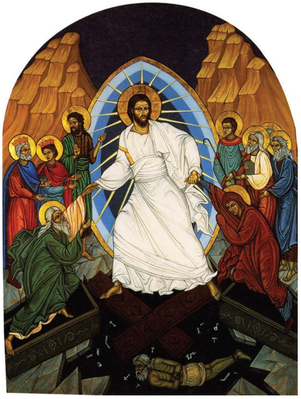 If you’ve ever seen the print edition of the OSB, you may have noticed the eight full-page, full-color icons interspersed throughout the pages. We have included these icons in the Accordance edition and have placed them together in one section. One of my favorites is the “Resurrection of Christ.”
If you’ve ever seen the print edition of the OSB, you may have noticed the eight full-page, full-color icons interspersed throughout the pages. We have included these icons in the Accordance edition and have placed them together in one section. One of my favorites is the “Resurrection of Christ.”
This image is filled with symbolism as one would expect in any Orthodox icon. Centered in the image, Jesus stands on the broken gates of Hades, which in their fallen state have formed a cross. Jesus is pulling the parents of humanity, Adam and Eve, from Hades by the wrists and not the hands because the work being done is all his and not theirs.
On Christ’s right hand are members of his family: King David, King Solomon, and John the Baptist. On his left are Abel (the first martyr), Moses and Isaiah. Under the demolished gates of Hades are numerous broken locks and chains. One figure is found bound: this is Death whose power has been defeated.
The OSB also contains 10 full-color biblical maps. As with any image in any Accordance resource, these may be exported for personal use and in preaching and teaching contexts.
As I mentioned above, the Orthodox Study Bible is suitable not only for Orthodox Christians, but also for anyone interested in the history of the Early Church. I often consider study Bibles a good “first step” in research. A more succinct understanding can be gained from the notes in a study Bible before going on to more detailed resources. If you regularly consult the very popular Ancient Christian Commentary Series, the OSB could function as a first step for research before diving into the ACCS.
 Orthodox Study Bible Notes (includes SAAS)
Orthodox Study Bible Notes (includes SAAS)
$34.90
 English Orthodox Bible (FREE upgrade for users who own Orthodox Study Bible AND either NKJV or NKJVS)
English Orthodox Bible (FREE upgrade for users who own Orthodox Study Bible AND either NKJV or NKJVS)
Free Upgrade


